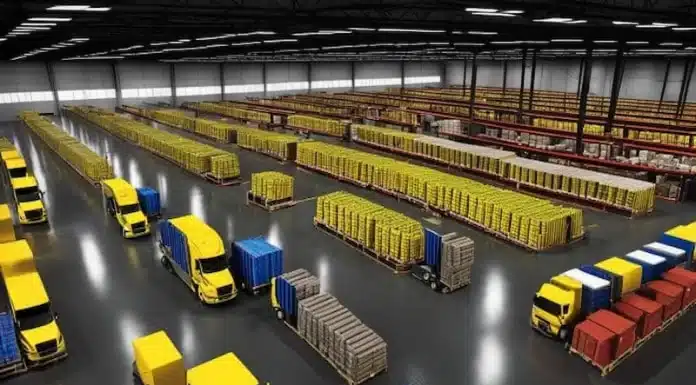Welcome to our informative article on how you can boost your operational efficiency with a cross dock warehouse. In today’s fast-paced business environment, supply chain optimization is crucial for staying ahead of the competition. By adopting a cross dock warehouse strategy, you can effectively streamline your logistics operations, maximize efficiency, and achieve significant cost savings.
A cross dock warehouse is a logistics solution that facilitates the direct transfer of goods from inbound trucks to outbound trucks without the need for storage. This eliminates unnecessary handling, storage costs, and delays, allowing you to expedite the movement of your products. By leveraging existing technologies and optimizing space utilization, a cross dock warehouse can revolutionize your supply chain management.
In this article, we will explore the fundamentals of cross docking and how it can enhance your operational efficiency. We’ll delve into the benefits of implementing a cross dock warehouse, such as reducing transportation costs, automating warehouse processes, and improving order fulfillment timeliness. We’ll also discuss the role of technology in optimizing cross dock warehouses and provide best practices for successful implementation.
If you’re looking to improve your supply chain efficiency and elevate your business performance, a cross dock warehouse may be the solution you need. Let’s dive into the details and discover the strategic advantages it can offer.
Understanding the Fundamentals of Cross Docking
Cross-docking is a logistics practice that allows for the efficient transfer of goods from inbound trucks to outbound trucks without the need for storage. It plays a crucial role in optimizing the supply chain and improving operational efficiency. To understand cross-docking, it’s important to familiarize yourself with its key fundamentals and models.
Distribution Center: Cross-docking requires a distribution center or warehouse as part of the retailer’s distribution network. This facility serves as the hub for receiving and transferring goods from suppliers to outbound trucks.
Flow-Through Model: In the flow-through model, retailers are alerted to the products that suppliers have packed and shipped. These products are pre-allocated for stores in advance of the delivery. This model ensures that items are ready for immediate distribution upon arrival at the cross dock warehouse.
Marked-For Model: In the marked-for model, retailers communicate the quantity of items needed to be pre-packed and labeled by store prior to shipping. This model allows for the efficient allocation of products specific to each store’s needs, streamlining the distribution process.
In addition to these models, specialized conveyor systems are often used in distribution centers that support cross-docking. These conveyor systems help distribute cartons to their respective destinations, ensuring smooth and efficient movement of goods.
Exploring the Benefits of a Cross Dock Warehouse
A cross dock warehouse offers numerous advantages for retailers and distributors, particularly in the retail and distribution sectors. One of the key benefits is the ability to achieve greater throughput without the need to open new warehouses or distribution centers.
By implementing a cross dock warehouse, businesses can reduce the time that items spend in the warehouse, leading to cost reductions associated with handling and storage. Additionally, cross docking enables faster and more efficient deliveries, improving overall operational efficiency.
Another advantage of cross docking is its ability to automate warehouse receiving processes. By automating tasks such as unloading and sorting, businesses can greatly increase efficiency and reduce costs.
From a buyer’s perspective, cross docking provides several advantages. Buyers can obtain volume discounts by consolidating orders and reducing transportation costs. With cross docking, timeliness in fulfilling orders is improved, leading to greater customer satisfaction. Furthermore, buyers can reduce labor costs and eliminate the need for individual store deliveries.
Sellers also benefit from implementing a cross dock warehouse. They can achieve reduced transportation costs by eliminating the need for multiple deliveries and optimizing delivery routes. The consolidation of Advance Ship Notice (ASN) data can be efficiently managed, leading to improved visibility and control. Fast product delivery to stores is another advantage for sellers, as it allows them to meet customer demand more effectively.
Streamlining Distribution with On-Demand Warehouses
On-demand warehouses offer a strategic solution for streamlining distribution in a cross-docking environment. These warehouses provide flexible storage and fulfillment options that can be tailored to the needs of specific products or customers. By leveraging on-demand warehouses, businesses can reduce costs by only paying for the space and services they actually use, making it a cost-effective way to optimize the supply chain and ensure smooth distribution processes.
On-demand warehouses offer the flexibility to scale operations according to demand fluctuations, allowing businesses to maintain cost-efficiency without compromising on service quality. With their ability to quickly adapt to changing market conditions, on-demand warehouses empower businesses to be more agile and responsive. This, in turn, enhances overall supply chain performance and customer satisfaction.
To reap the benefits of on-demand warehouses, businesses can partner with third-party logistics providers (3PLs) that specialize in providing flexible storage and fulfillment solutions. These 3PLs offer a range of services, including inventory management, order fulfillment, and reverse logistics, all designed to meet the unique needs of each business. By outsourcing warehousing and distribution to experienced 3PLs, businesses can focus on their core competencies while enjoying the advantages of on-demand warehousing.
In summary, on-demand warehouses are a valuable tool for streamlining distribution in a cross-docking environment. With their flexibility and cost-effectiveness, they enable businesses to optimize their supply chain operations and deliver superior service to their customers. By embracing the power of on-demand warehousing, businesses can stay competitive in today’s fast-paced and dynamic marketplace.
The Role of Technology in Optimizing Cross Dock Warehouses
Technology plays a crucial role in optimizing cross dock warehouses. To streamline operations and improve efficiency, warehouse management systems (WMS) are essential. These systems automate data exchange between buyers and sellers, ensuring accurate planning and real-time visibility of goods. They handle processes such as electronic purchase orders, advance ship notices, and inventory control management, enabling seamless coordination throughout the supply chain.
In addition to WMS, automation is key to enhancing efficiency in cross dock warehouses. The use of conveyor systems and sorters reduces manual labor and improves the accuracy and speed of order fulfillment. By integrating technologies like barcode scanning and RFID tracking, cross dock warehouses can optimize inventory accuracy, reduce errors, and expedite the movement of goods.
Implementing Cross Docking for Increased Efficiency
Implementing cross docking in your supply chain requires careful planning, communication, and coordination. To ensure a successful implementation, follow these best practices:
- Select the right products: When implementing cross docking, it’s essential to select the appropriate products for this process. Consider factors such as demand, variability, and supply predictability. By choosing the right products, you can optimize the efficiency of cross docking and avoid potential disruptions in your supply chain.
- Optimize the layout and design: The layout and design of your cross dock facility play a crucial role in ensuring the smooth movement of goods. Arrange the docking areas in a way that minimizes congestion and allows for seamless transfer between incoming and outgoing trucks. In addition, consider the flow of materials and the accessibility of equipment to optimize efficiency.
- Integrate systems and processes: Integration of systems and processes, such as Warehouse Management Systems (WMS) and Transportation Management Systems (TMS), is vital for real-time visibility and control. These systems enable you to track and monitor the movement of goods, manage inventory, and streamline operations. Implementing cross docking without proper integration can result in inefficiencies and errors.
- Monitor and measure performance: To ensure the effectiveness of cross docking, it’s important to monitor and measure performance using Key Performance Indicators (KPIs). Track metrics such as on-time delivery, order accuracy, and dock utilization to identify areas for improvement. Regularly evaluate performance data and make necessary adjustments to enhance operational efficiency.
- Adhere to best practices: Adhering to industry best practices is crucial for implementing cross docking successfully. Stay updated on the latest trends, technologies, and strategies related to cross docking. Seek guidance from experts and learn from the experiences of other businesses that have implemented cross docking in their operations.
- Communicate and coordinate: Effective communication and coordination among all stakeholders are vital for the smooth implementation of cross docking. Ensure that all parties involved, including suppliers, carriers, and warehouse staff, are aware of the cross docking process and their respective roles. Regularly communicate with them to address any issues or concerns that may arise.
Maximizing the Advantages of Warehouse Clustering Through Cross-Docking
Warehouse clustering is a strategic approach in supply chain optimization that involves grouping multiple warehouses in one location. This clustering enables businesses to streamline their distribution network, reduce inventory costs, and improve overall efficiency.
By implementing cross-docking practices within warehouse clusters, companies can further enhance collaboration and maximize the benefits of this strategic approach. Cross-docking allows for the seamless transfer of goods between clustered warehouses, eliminating the need for individual store deliveries and reducing transportation costs.
With warehouse clustering and cross-docking, businesses can optimize their supply chain processes, improve operational efficiency, and achieve cost savings. By strategically locating warehouses in close proximity, companies can minimize transportation distances and expedite the flow of goods. This approach also enables better coordination and collaboration between warehouses, leading to smoother operations and enhanced customer satisfaction.
By combining warehouse clustering with cross-docking, businesses can take their supply chain optimization efforts to the next level. This integrated approach allows for efficient distribution, reduced inventory holding costs, and improved response times to customer demands. Collaboration between clustered warehouses becomes seamless, enabling companies to achieve higher levels of efficiency and cost-effectiveness.
The Strategic Edge: Fulfillment Warehousing with Cross Dock Warehouse
Fulfillment warehousing within a cross dock warehouse provides a strategic edge in the world of e-commerce and order fulfillment. With the increasing demands of the modern consumer, businesses need efficient solutions to meet customer expectations and stay competitive. By integrating cross docking with fulfillment operations, you can ensure quick and efficient order processing and delivery, resulting in improved customer satisfaction and reduced order processing times.
One of the key advantages of fulfillment warehousing with cross dock capabilities is the ability to receive, sort, and ship orders within a single facility. This streamlined approach eliminates the need for multiple touchpoints, reducing the risk of errors and delays in order fulfillment. By centralizing your fulfillment operations, you can optimize your order processing workflow and achieve faster turnaround times.
In the fast-paced world of e-commerce, timely delivery is crucial to customer satisfaction. With a cross dock warehouse, you can expedite the order fulfillment process by bypassing the need for storage. The goods are received, sorted, and immediately shipped, allowing for swift dispatch and delivery to your customers. This not only enhances the efficiency of your operations but also improves customer experience, resulting in higher satisfaction and increased loyalty.
If you’re looking to enhance the efficiency of your cross-dock warehouse operations, consider HashMicro’s Warehouse Management System. Tailored to support the unique demands of cross-docking, this software ensures seamless coordination of incoming and outgoing shipments, minimizes handling times, and reduces storage needs.
By streamlining these critical processes, you can optimize space utilization and improve turnaround times. Interested in transforming your cross-dock warehouse operations? Click the banner below to explore how HashMicro’s solution can assist you in achieving smoother, faster, and more cost-effective logistics management.








































